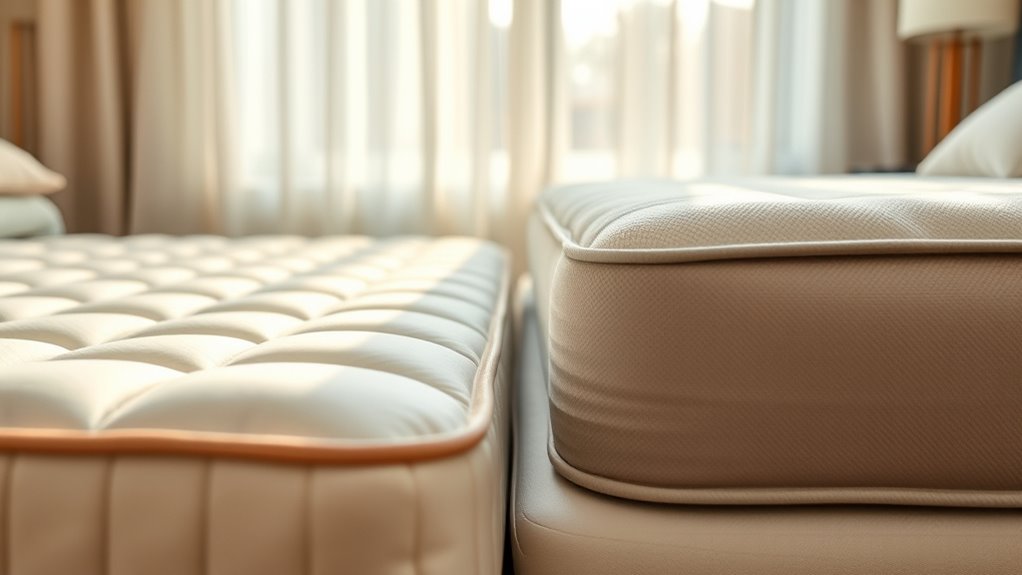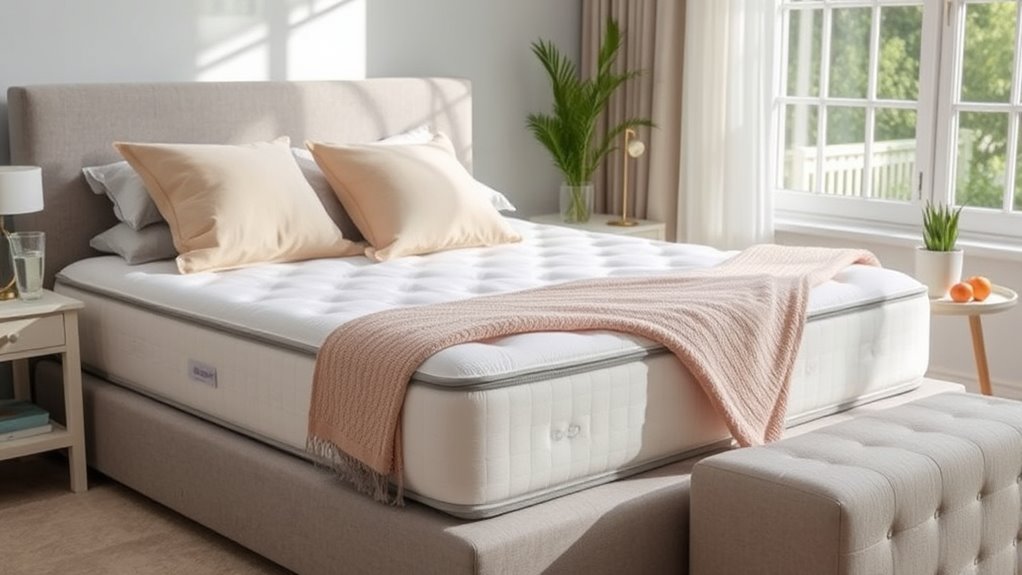After 40, your sleep needs change, requiring a mattress that offers proper support and comfort. Look for features like memory foam for pressure relief or adjustable firmness to match your evolving preferences. Consider mattress types—memory foam, innerspring, or hybrids—based on support and breathability. Try out different options by lying down in your usual sleep position, and remember to maintain your mattress regularly for longevity. Keep exploring to discover the best choices tailored for your needs.
Key Takeaways
- Prioritize mattresses with good support and spinal alignment to accommodate changing sleep patterns after 40.
- Consider memory foam or hybrid options for pressure relief and comfort tailored to aging joints.
- Test mattress firmness by lying in your usual sleep position for at least 15 minutes before buying.
- Look for features like adjustable firmness and hypoallergenic materials to suit evolving needs.
- Maintain and rotate your mattress regularly to extend its lifespan and ensure consistent support.
Understanding Your Changing Sleep Needs

As you age, your sleep needs and patterns naturally change, making it important to understand these shifts. You might notice more fragmented sleep or longer periods of wakefulness during the night. Good sleep hygiene becomes essential to improve overall rest, such as sticking to a consistent sleep schedule and creating a calming bedtime routine. Your dream patterns may also evolve, with fewer vivid dreams or changes in REM sleep cycles. Recognizing these shifts helps you address potential issues early and adapt your sleep environment accordingly. Understanding your changing sleep needs allows you to prioritize habits that promote restful sleep, ensuring you wake feeling refreshed and alert. Additionally, choosing a comfortable mattress suited to your changing needs can significantly improve sleep quality. Incorporating air quality improvements, such as ensuring proper ventilation and reducing indoor pollutants, can further enhance your sleep environment and overall rest quality. Moreover, understanding the sleep cycle dynamics can help you develop better habits for more restorative sleep. Staying informed about age-related sleep changes can empower you to make proactive adjustments to your sleep routine.
Key Features to Look for in a Mattress

Choosing the right mattress after 40 means focusing on features that support your changing sleep needs. Look for a mattress with memory foam, which contours to your body and relieves pressure points, helping you wake up feeling refreshed. Adjustable firmness is also key, as your preferences and comfort levels may shift over time. A mattress with customizable firmness allows you to find the perfect balance between softness and support. Consider models that let you modify firmness on each side if sharing with a partner. Additionally, prioritize quality materials that promote proper spinal alignment and reduce aches. Incorporating sound healing science principles into your sleep environment, such as calming sounds or frequencies, can further enhance restful sleep. Using trustworthiness and safety features in your mattress choice can help ensure durability and peace of mind. Exploring crochet styles for locs can provide a relaxing activity that promotes relaxation before bedtime. Paying attention to sleep environment optimization ensures you get restful sleep, supports your body’s evolving needs, and helps you wake up feeling more energized each day.
Comparing Mattress Types: Pros and Cons

When evaluating different mattress types, understanding their pros and cons helps you make an informed decision that suits your changing needs after 40. Memory foam mattresses excel at contouring your body and relieving pressure points, which is beneficial if you experience joint or back pain. However, they can retain heat, making them less ideal for hot sleepers. Innerspring mattresses offer strong support and good airflow, helping regulate temperature, but they may lack the pressure relief some people need and tend to wear out faster.
- Memory foam conforms closely to your body but can trap heat
- Innerspring provides support and breathability but may be less durable
- Hybrid options combine features but often come at a higher cost
Tips for Testing and Trying Out Mattresses

Trying out a mattress in person is the best way to guarantee it meets your comfort and support needs. When testing, pay attention to your sleep posture—whether you sleep on your side, back, or stomach—and see how the mattress supports your spine. Lie down in your usual sleeping position for at least 10-15 minutes to get a true feel. If you have allergy considerations, look for hypoallergenic materials and check for dust mite resistance. Don’t rush the process; take your time to sit, lie down, and move around to assess comfort and support. Remember, a mattress that feels good now should also support your body throughout the night, helping you wake up refreshed and free of discomfort. Understanding performance tuning principles can also help you choose a mattress that maintains its supportive qualities over time. Additionally, consider testing the mattress in different sleep environments to ensure consistent comfort and support. Being aware of AI discoveries related to material properties might also inform your choice for long-term durability.
Maintaining Your Mattress for Longevity

Proper mattress maintenance is essential to prolong its lifespan and guarantee continued comfort. Regular care helps prevent sagging and keeps your bed supportive. To maintain your mattress, consider adjusting the bed height to make it easier to get in and out, especially after 40. Using mattress toppers can also shield the surface from stains and wear, extending its durability. Additionally, rotating your mattress every few months prevents uneven sagging and maintains uniform support. Keep the bed clean by vacuuming regularly and using a protective cover. Avoid jumping on the bed or placing heavy objects that can damage the structure. Proper maintenance ensures your mattress remains comfortable and supportive, helping you get restful sleep for years to come. Incorporating local tips can also help you address specific issues like humidity or dust that may affect your mattress over time, and understanding mattress materials can guide you in selecting the best options for longevity. Staying informed about AI in Education advancements can inspire innovative solutions to enhance your sleep environment and overall comfort. Paying attention to luxurious tiny house design elements like high-quality textiles and smart storage solutions can also enhance your overall sleep environment.
Frequently Asked Questions
How Often Should I Replace My Mattress After Age 40?
Your mattress lifespan typically ranges from 7 to 10 years. After age 40, it’s wise to follow a regular replacement schedule to ensure proper support and comfort. You should consider replacing your mattress every 8 to 10 years, or sooner if you notice sagging, discomfort, or sleep disturbances. Staying attentive to these signs helps maintain good sleep quality and prevents long-term health issues related to poor mattress support.
Are Organic or Eco-Friendly Mattresses Better for Mature Sleepers?
You might wonder if organic or eco-friendly mattresses are better for mature sleepers. These mattresses use organic materials and eco-conscious choices, which can be gentler on your skin and respiratory system, especially as you age. They also tend to be free from harmful chemicals, providing a healthier sleep environment. If you prioritize sustainability and health, opting for an organic mattress can be a smart, comfortable choice for your evolving needs.
What Sleep Positions Are Ideal for Choosing a Mattress at 40+?
Imagine lying down and feeling perfectly supported—that’s where sleep ergonomics come in. At 40+, your ideal sleep position depends on your needs. If you sleep on your side, find a mattress with good pillow support to cushion your shoulders and hips. Back sleepers benefit from a medium-firm surface that maintains spinal alignment. Stomach sleepers should prioritize firmness and pillow support to prevent strain. Your perfect mattress aligns with your sleep position for restful, rejuvenating sleep.
How Do I Know if My Mattress Is Contributing to Joint Pain?
If you’re experiencing joint discomfort, your mattress might be the culprit. Pay attention to how your joints feel after sleeping—if pain or stiffness persists, your mattress firmness could be off. A mattress that’s too soft may not support your body properly, while one that’s too firm can cause pressure points. Consider trying a medium firmness mattress and see if your joint pain improves. Proper support can make a significant difference in reducing joint discomfort.
Can a Mattress Topper Improve Sleep Quality for Older Adults?
A mattress topper can definitely improve your sleep quality, especially if you’re an older adult. You might want to look for one with memory foam for added comfort and support, reducing pressure points. Cooling gel layers help regulate temperature, preventing overheating and ensuring a more restful night. By choosing a topper with these features, you can enhance your sleep experience without needing to replace your entire mattress.
Conclusion
Choosing the right mattress after 40 isn’t just a small decision; it’s the secret weapon to waking up feeling like you’ve conquered the world every morning. With the perfect mattress, you’ll dodge aches, crush stress, and feel so energized, you might start thinking you’re invincible! So don’t settle for less—your best sleep and unstoppable mornings are waiting. Make the right choice today and release your inner superstar tomorrow!









